HiPOD: Bedrock Exposures In Nirgal Vallis


HiPOD: Bedrock Exposures in Nirgal Vallis
This observation covers two tributaries and the main channel of Nirgal Vallis. The channel is approximately 610 kilometers long and is named after Nergal, the Babylonian god of war and counterpart to the Roman god of war, Mars. Mars Orbiter Camera image show light-toned bedrock; our high resolution picture can gives us a better view of the channel form and bedrock stratigraphy. (Grayscale cutout is less than 5 km across; enhanced color is less than 1 km.)
ID: ESP_074945_1515 date: 23 July 2022 altitude: 257 km
NASA/JPL-Caltech/UArizona
More Posts from Epic-flight and Others

John Berkey cover art for The Plain Truth, April 1978.
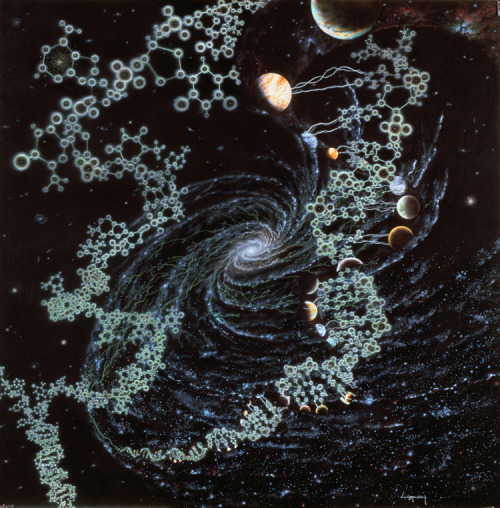
Jon Lomberg

Lynds Dark Nebula 1251 : Stars are forming in Lynds Dark Nebula (LDN) 1251. About 1,000 light-years away and drifting above the plane of our Milky Way galaxy, the dusty molecular cloud is part of a complex of dark nebulae mapped toward the Cepheus flare region. Across the spectrum, astronomical explorations of the obscuring interstellar clouds reveal energetic shocks and outflows associated with newborn stars, including the telltale reddish glow from scattered Herbig-Haro objects seen in this sharp image. Distant background galaxies also lurk on the scene, buried behind the dusty expanse. This alluring view imaged with a backyard telescope and broadband filters spans about two full moons on the sky, or 17 light-years at the estimated distance of LDN 1251. via NASA

The Pipe Nebula : East of Antares, dark markings sprawl through crowded star fields toward the center of our Milky Way Galaxy. Cataloged in the early 20th century by astronomer E. E. Barnard, the obscuring interstellar dust clouds include B59, B72, B77 and B78, seen in against the starry background. Here, their combined shape suggests a pipe stem and bowl, and so the dark nebula’s popular name is the Pipe Nebula. The deep and expansive view covers a full 10 by 10 degree field in the pronounceable constellation Ophiuchus. The Pipe Nebula is part of the Ophiuchus dark cloud complex located at a distance of about 450 light-years. Dense cores of gas and dust within the Pipe Nebula are collapsing to form stars. via NASA
This impressive storm captured by Geoff Green over West Australia in August 2018, gives you an idea of the huge frequency at which lightning happen in an extreme weather event
Instagram: wonders_of_the_cosmos

Seven Sisters surrounded by cosmic dust © astrofalls

Peering deep into the core of the Crab Nebula, this close-up image reveals the beating heart of one of the most historic and intensively studied remnants of a supernova, an exploding star. The inner region sends out clock-like pulses of radiation and tsunamis of charged particles embedded in magnetic fields.
The neutron star at the very center of the Crab Nebula has about the same mass as the sun but compressed into an incredibly dense sphere that is only a few miles across. Spinning 30 times a second, the neutron star shoots out detectable beams of energy that make it look like it’s pulsating.
The Hubble Space Telescope snapshot is centered on the region around the neutron star (the rightmost of the two bright stars near the center of this image) and the expanding, tattered, filamentary debris surrounding it. Hubble’s sharp view captures the intricate details of glowing gas, shown in red, that forms a swirling medley of cavities and filaments. Inside this shell is a ghostly blue glow that is radiation given off by electrons spiraling at nearly the speed of light in the powerful magnetic field around the crushed stellar core.
Read more about this image HERE.
Make sure to follow us on Tumblr for your regular dose of space: http://nasa.tumblr.com
You Are Made of Stardust
Though the billions of people on Earth may come from different areas, we share a common heritage: we are all made of stardust! From the carbon in our DNA to the calcium in our bones, nearly all of the elements in our bodies were forged in the fiery hearts and death throes of stars.
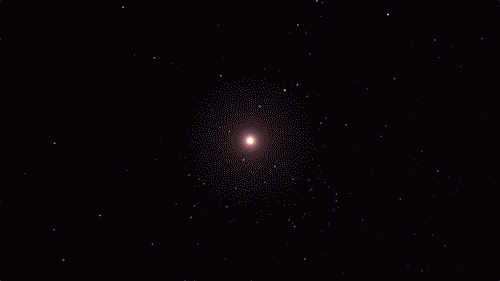
The building blocks for humans, and even our planet, wouldn’t exist if it weren’t for stars. If we could rewind the universe back almost to the very beginning, we would just see a sea of hydrogen, helium, and a tiny bit of lithium.
The first generation of stars formed from this material. There’s so much heat and pressure in a star’s core that they can fuse atoms together, forming new elements. Our DNA is made up of carbon, hydrogen, oxygen, nitrogen, and phosphorus. All those elements (except hydrogen, which has existed since shortly after the big bang) are made by stars and released into the cosmos when the stars die.

Each star comes with a limited fuel supply. When a medium-mass star runs out of fuel, it will swell up and shrug off its outer layers. Only a small, hot core called a white dwarf is left behind. The star’s cast-off debris includes elements like carbon and nitrogen. It expands out into the cosmos, possibly destined to be recycled into later generations of stars and planets. New life may be born from the ashes of stars.
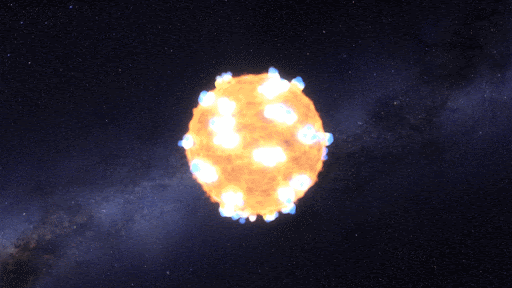
Massive stars are doomed to a more violent fate. For most of their lives, stars are balanced between the outward pressure created by nuclear fusion and the inward pull of gravity. When a massive star runs out of fuel and its nuclear processes die down, it completely throws the star out of balance. The result? An explosion!
Supernova explosions create such intense conditions that even more elements can form. The oxygen we breathe and essential minerals like magnesium and potassium are flung into space by these supernovas.
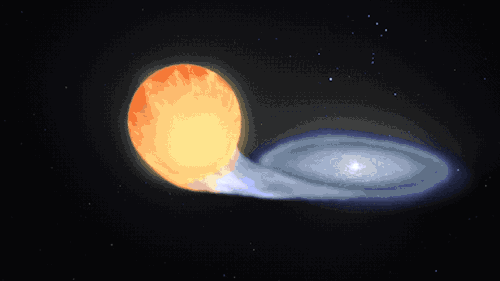
Supernovas can also occur another way in binary, or double-star, systems. When a white dwarf steals material from its companion, it can throw everything off balance too and lead to another kind of cataclysmic supernova. Our Nancy Grace Roman Space Telescope will study these stellar explosions to figure out what’s speeding up the universe’s expansion.
This kind of explosion creates calcium – the mineral we need most in our bodies – and trace minerals that we only need a little of, like zinc and manganese. It also produces iron, which is found in our blood and also makes up the bulk of our planet’s mass!

A supernova will either leave behind a black hole or a neutron star – the superdense core of an exploded star. When two neutron stars collide, it showers the cosmos in elements like silver, gold, iodine, uranium, and plutonium.

Some elements only come from stars indirectly. Cosmic rays are nuclei (the central parts of atoms) that have been boosted to high speed by the most energetic events in the universe. When they collide with atoms, the impact can break them apart, forming simpler elements. That’s how we get boron and beryllium – from breaking star-made atoms into smaller ones.
Half a dozen other elements are created by radioactive decay. Some elements are radioactive, which means their nuclei are unstable. They naturally break down to form simpler elements by emitting radiation and particles. That’s how we get elements like radium. The rest are made by humans in labs by slamming atoms of lighter elements together at super high speeds to form heavier ones. We can fuse together elements made by stars to create exotic, short-lived elements like seaborgium and einsteinium.
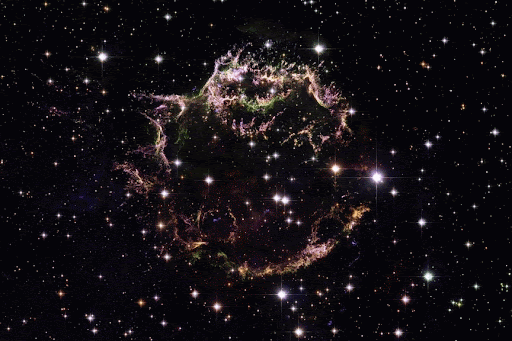
From some of the most cataclysmic events in the cosmos comes all of the beauty we see here on Earth. Life, and even our planet, wouldn’t have formed without them! But we still have lots of questions about these stellar factories.
In 2006, our Stardust spacecraft returned to Earth containing tiny particles of interstellar dust that originated in distant stars, light-years away – the first star dust to ever be collected from space and returned for study. You can help us identify and study the composition of these tiny, elusive particles through our Stardust@Home Citizen Science project.
Our upcoming Roman Space Telescope will help us learn more about how elements were created and distributed throughout galaxies, all while exploring many other cosmic questions. Learn more about the exciting science this mission will investigate on Twitter and Facebook.
Make sure to follow us on Tumblr for your regular dose of space!
"Two possibilities exist: either we are alone in the Universe or we are not. Both are equally terrifying.”
Arthur C. Clarke
Via nowspacetime
animation by ©️Harry Evett

Scorpius Rising, photographed from Mt. Laguna, California. (Hendren Imaging)
-
 xploseof reblogged this · 10 months ago
xploseof reblogged this · 10 months ago -
 galaxy-starshine reblogged this · 1 year ago
galaxy-starshine reblogged this · 1 year ago -
 hyperactivehd reblogged this · 1 year ago
hyperactivehd reblogged this · 1 year ago -
 hyperactivehd liked this · 1 year ago
hyperactivehd liked this · 1 year ago -
 dunmertwink liked this · 1 year ago
dunmertwink liked this · 1 year ago -
 fapaul24 liked this · 1 year ago
fapaul24 liked this · 1 year ago -
 libiccoco liked this · 1 year ago
libiccoco liked this · 1 year ago -
 xploseof liked this · 1 year ago
xploseof liked this · 1 year ago -
 ratemybreakdown liked this · 1 year ago
ratemybreakdown liked this · 1 year ago -
 kevinmb63 liked this · 1 year ago
kevinmb63 liked this · 1 year ago -
 that-one-queer-poc liked this · 1 year ago
that-one-queer-poc liked this · 1 year ago -
 fuckyeahcelestialthings reblogged this · 1 year ago
fuckyeahcelestialthings reblogged this · 1 year ago -
 starwriter1937 liked this · 1 year ago
starwriter1937 liked this · 1 year ago -
 comfycat3 liked this · 1 year ago
comfycat3 liked this · 1 year ago -
 yourmama-68 liked this · 1 year ago
yourmama-68 liked this · 1 year ago -
 epic-flight reblogged this · 1 year ago
epic-flight reblogged this · 1 year ago -
 commanderspock reblogged this · 1 year ago
commanderspock reblogged this · 1 year ago -
 the-puffinry liked this · 1 year ago
the-puffinry liked this · 1 year ago -
 tyrannosaurus-mother-fucking-rex liked this · 1 year ago
tyrannosaurus-mother-fucking-rex liked this · 1 year ago -
 archeanbutch liked this · 1 year ago
archeanbutch liked this · 1 year ago -
 sivuaa liked this · 1 year ago
sivuaa liked this · 1 year ago -
 theegoist liked this · 1 year ago
theegoist liked this · 1 year ago -
 obliquecompendium reblogged this · 1 year ago
obliquecompendium reblogged this · 1 year ago -
 rockfarkas liked this · 1 year ago
rockfarkas liked this · 1 year ago -
 settima liked this · 1 year ago
settima liked this · 1 year ago -
 dcatwood1 reblogged this · 1 year ago
dcatwood1 reblogged this · 1 year ago -
 daddysbabyhoeneybee liked this · 1 year ago
daddysbabyhoeneybee liked this · 1 year ago -
 thepetrichorist liked this · 1 year ago
thepetrichorist liked this · 1 year ago -
 starhasarrived reblogged this · 1 year ago
starhasarrived reblogged this · 1 year ago -
 starhasarrived liked this · 1 year ago
starhasarrived liked this · 1 year ago -
 spacetimewithstuartgary reblogged this · 1 year ago
spacetimewithstuartgary reblogged this · 1 year ago -
 spacetimewithstuartgary liked this · 1 year ago
spacetimewithstuartgary liked this · 1 year ago -
 bibliophiliosaurus reblogged this · 1 year ago
bibliophiliosaurus reblogged this · 1 year ago -
 shannon-foraker reblogged this · 1 year ago
shannon-foraker reblogged this · 1 year ago -
 enginigger liked this · 1 year ago
enginigger liked this · 1 year ago -
 steve51world liked this · 1 year ago
steve51world liked this · 1 year ago -
 boyplushie liked this · 1 year ago
boyplushie liked this · 1 year ago -
 sarnakhwritesthings reblogged this · 1 year ago
sarnakhwritesthings reblogged this · 1 year ago -
 sarnakhwritesthings liked this · 1 year ago
sarnakhwritesthings liked this · 1 year ago -
 thesignificantowlhootsinthenight liked this · 1 year ago
thesignificantowlhootsinthenight liked this · 1 year ago -
 twothirdsgenius liked this · 1 year ago
twothirdsgenius liked this · 1 year ago -
 beautifulmars reblogged this · 1 year ago
beautifulmars reblogged this · 1 year ago
